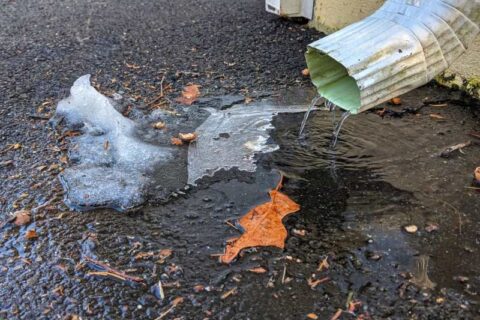Summer Basements & Potential Moisture Issues
As summer approaches, you may long to escape the heat by retreating downstairs to the cool basement. Unfortunately, moisture problems are incredibly common in underground spaces, especially in Maryland’s humid climate. Excessive moisture could damage your home and threaten your health. Learn more about the potential moisture issues that plague your basement and what to do about them.
Sources of Moisture Problems in the Basement
Before you can hope to fix wet basement issues, you must understand where the water is coming from. There are only two sources of moisture in a basement: liquid water and humidity.
Liquid Water
A storm that produces one inch of rainfall sends over 1,200 gallons of water flowing off the roof of a 2,000-square-foot, single-story home. This saturates the soil around the foundation and raises the water table. As a result, every belowground structure is at risk. Water can enter from the soil outside through the following means:
- Capillary suction: This is the movement of moisture through porous materials, such as concrete basement walls.
- Vapor diffusion: This is the movement of moisture through materials while in its vapor state. In basements, vapor diffuses from the wet ground outside toward the relatively dry basement interior.
- Liquid water flow: Any substantial cracks in the foundation or leaks in basement windows may allow stormwater to flow inside. A rising water table may also cause a basement to flood from the ground up.
- Air leakage: The stack effect is a phenomenon that occurs in most houses because warm air rises. When this happens, negative pressure develops in the basement, which draws moist air through any cracks or openings in the foundation.
Humidity
It’s nice to open the windows for ventilation on a pleasant day, but outdoor air is usually more humid than indoor air in the summer. Therefore, opening the windows invites condensation to form on cool basement surfaces. This can make it appear as though you have a wall leak when, in fact, humid air from outside is to blame. Daily indoor activities such as cooking, showering, and doing laundry can also raise basement humidity levels.
Symptoms of Moisture Issues in the Basement
You might have a wet basement if you notice any of the following:
- Water trickling out of the walls
- Standing water on the floor
- Saturated concrete block walls
- Damp, humid air
- Condensation on cold surfaces
- Visible mold and mildew
- Lingering musty odors
- Deteriorated carpet or buckling wood floors
- Rotting wood joists, sill plates, or structural columns
- Staining or blistering paint and wallpaper
- White, salty deposits on the surface of stone, brick, or plaster walls (known as efflorescence)
Common Causes & Solutions for Moist Summer Basements
Sources of moisture will always be present in and around your home. The trick is to prevent them from causing problems in the basement. Here are the issues that most often lead to moisture issues and how to mitigate their effect.
Inadequate Grading
If the ground slopes toward your house, water is directed toward your basement every time it rains. Even watering the grass could cause problems. The solution is to improve the grading around your home so the ground slopes away from the foundation. The minimum recommended slope is one inch of rise per six feet of run.
Leaky, Clogged, or Missing Gutters and Downspouts
Runoff from the roof is a major source of basement flooding. If you don’t have gutters, install them. Then, maintain your gutters to prevent leaks and clogs. Clean the gutters twice a year to remove leaf litter or install a guard system to keep them free of debris. Also, set up downspout extenders to direct rainwater at least four feet away from the foundation. Sloped concrete sidewalks are also very useful for redirecting runoff.
Poorly Designed Window Wells
While they allow you to install full-sized windows for maximum light in the basement, window wells act like a drain sitting right next to the basement wall. To prevent directing rainwater toward the house, make sure the bottom of the window well slopes away from the wall. It’s also wise to install drain tile at the base of every window well.
Missing or Ineffective Drainage System
Many existing homes were built with no subsurface drainage, leaving them prone to moisture problems and flooding. Fortunately, solutions can be installed in existing homes to improve drainage, including exterior French drains, perimeter drains within the foundation footings, and sump pumps.
Foundation Cracks
Concrete foundations may crack due to poor drainage, soil settling, freeze/thaw cycles, or improper construction techniques. Water can seep through these cracks and lead to moisture issues. While it’s best to avoid concrete foundation cracks, it’s also possible to fix them with professional foundation repair.
High Outdoor Humidity
The most obvious way to keep moist summer air from infiltrating your home is to keep the windows closed, but this isn’t enough. As previously discussed, vapor can diffuse through the very walls of your basement. To prevent this, you need to take a multi-faceted approach, which includes air sealing the basement walls, installing a vapor barrier, and putting in basement insulation.
High Indoor Humidity
Indoor relative humidity should stay below about 50 percent to prevent condensation. Keeping moist outdoor air from getting inside is a good start, but you must also control the humidity generated indoors. Here’s what we recommend:
- Run exhaust fans in the kitchen, bathroom, and laundry room when cooking, showering, or running the clothes dryer.
- Install a dehumidifier in the basement. Keep in mind that this is only effective if you also have a vapor barrier. Otherwise, relatively dry basement air will draw moisture through the concrete, causing efflorescence and further damage to basement finishes.
- Vent the clothes dryer to the exterior or hang laundry outside to dry. Many dryers are either unvented or vented to the basement. Make sure you send hot, moist air outside with proper ventilation.
- Use lids when cooking to prevent steam from adding vapor to the air.
- Fix plumbing leaks that introduce standing water, humidity, and mold growth.
- Install insulation on cold-water pipes to keep condensation at bay.
- Avoid storing damp firewood in the basement. This adds moisture to the air as it dries and attracts pests into your home.
Basement Waterproofing Services
If you’re struggling with moisture issues in your basement this summer, don’t ignore the problem. Eventually, high humidity, condensation, and mold growth will take their toll on your home’s structural integrity and air quality. Team up with the experts at Budget Waterproofing to employ a combination of techniques aimed at keeping moisture out once and for all.
To schedule basement waterproofing services in Baltimore, Linthicum Heights, or Frederick County, MD, please contact us today.


